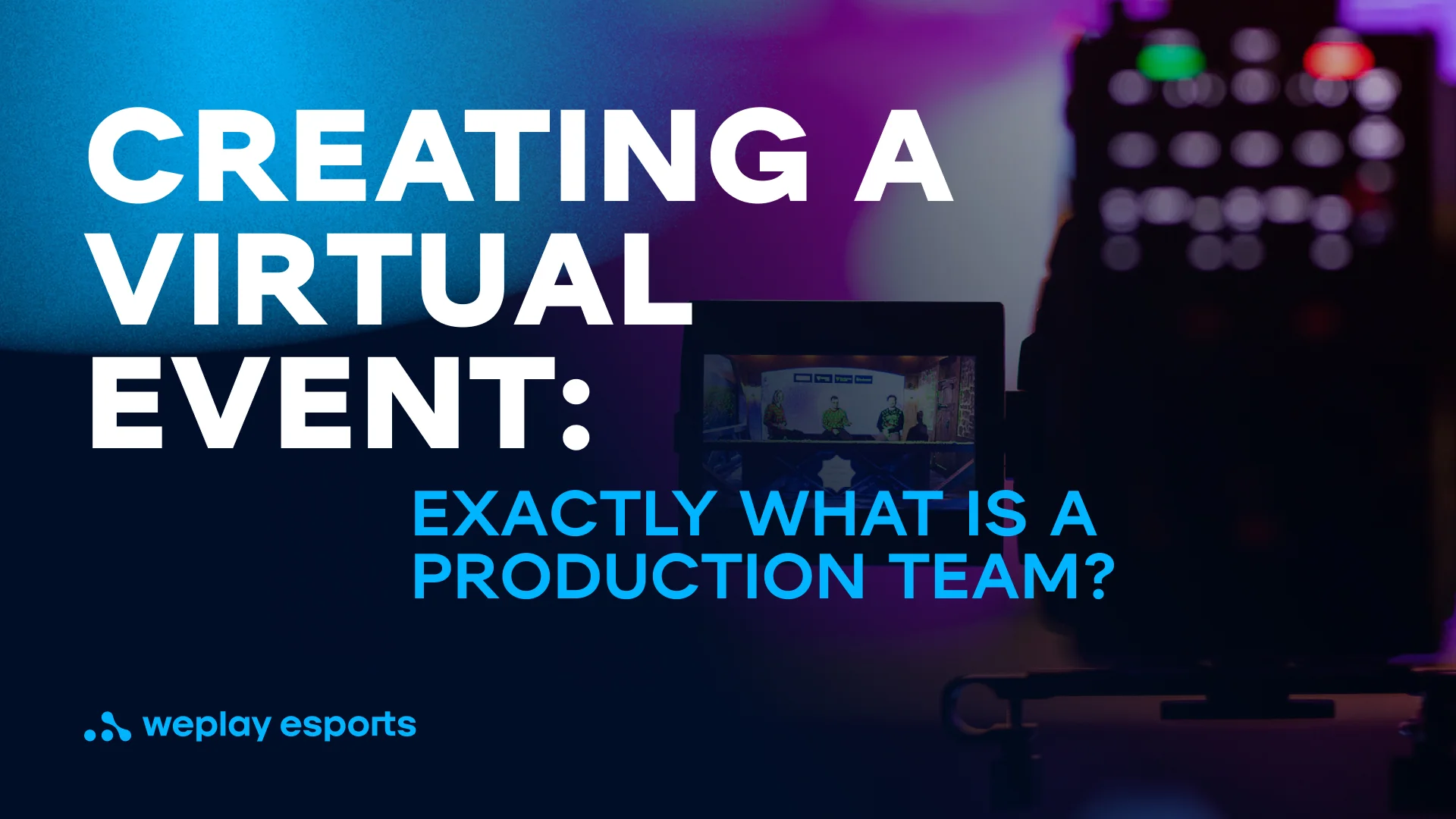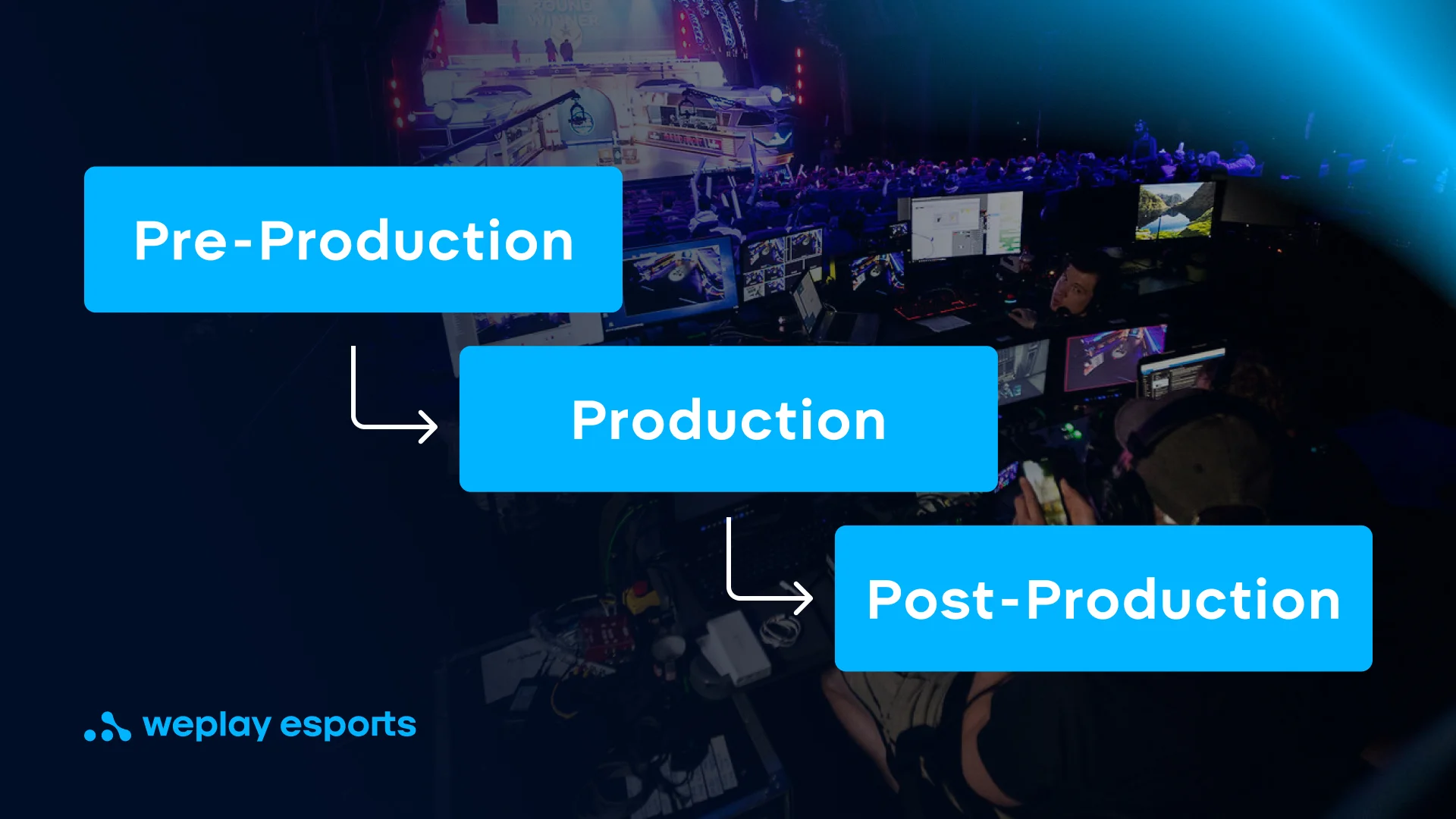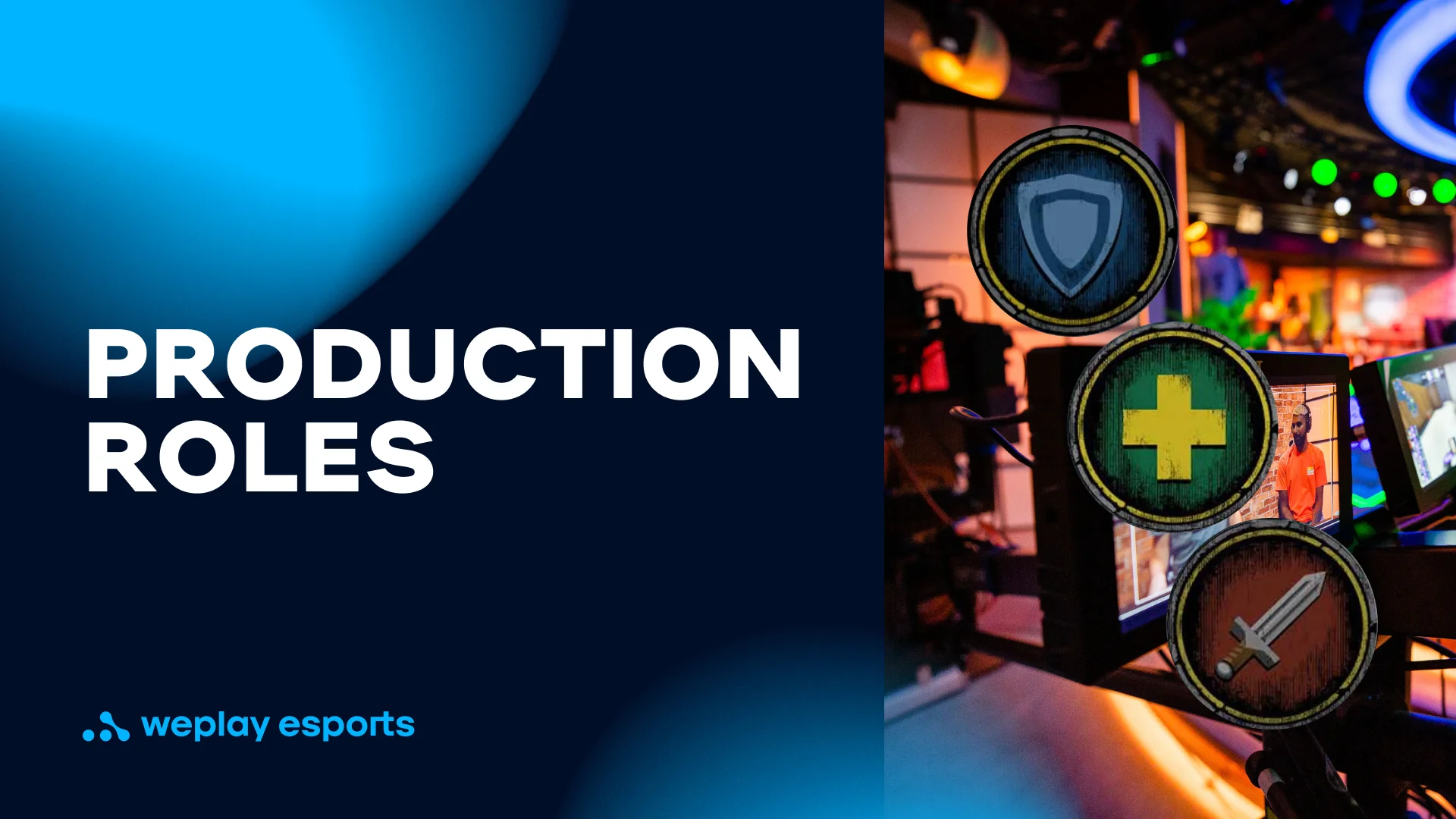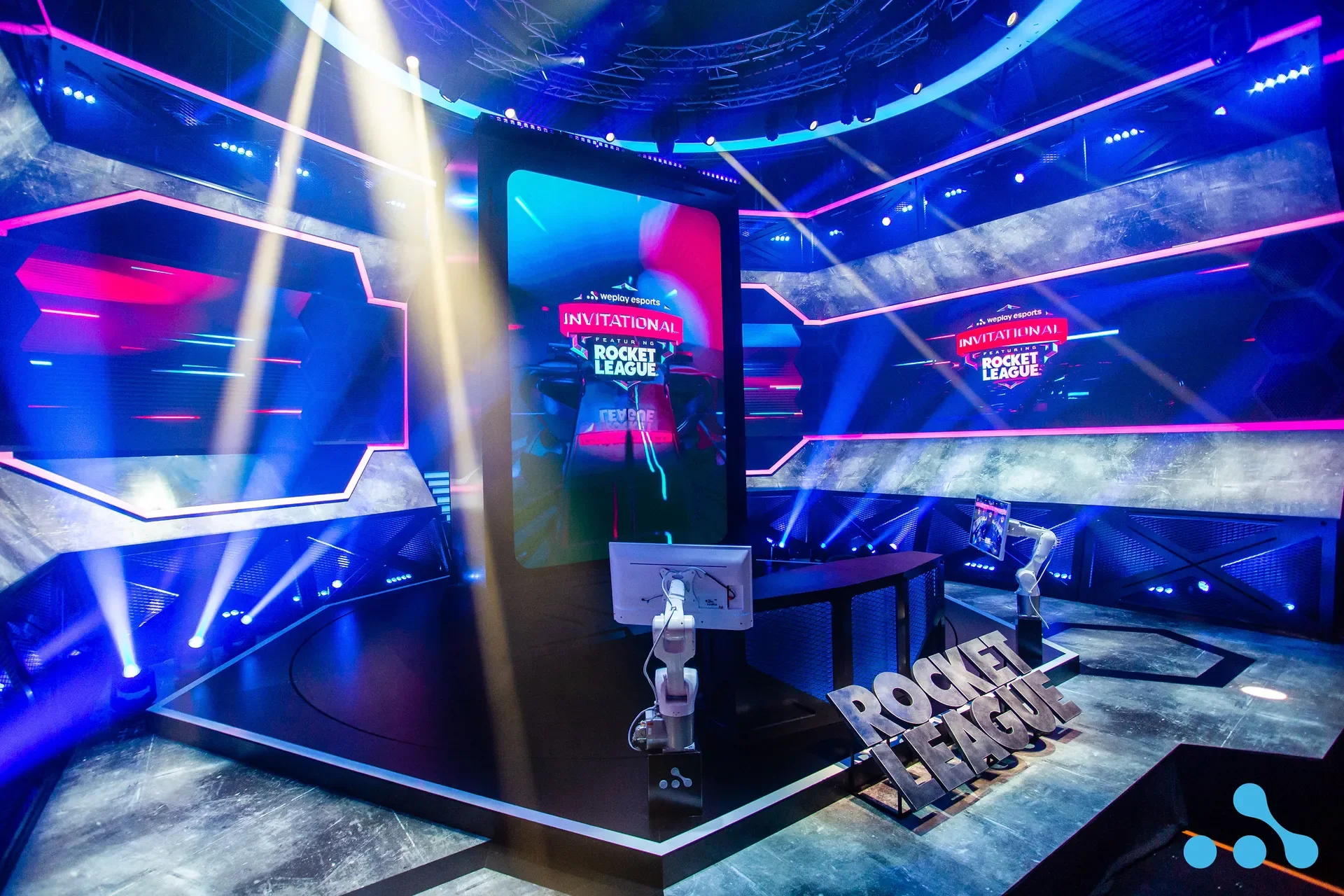April 14, 2023
Creating a virtual event: Exactly what is a production team?

6 min read
Each WePlay event is a point of pride for our company and each employee. Every detail of the event, from lighting installation to set decorations, is a product of the hard work of a vast team. The average viewer can probably only think of a few roles, so today, this article will take a closer look at the production team structure. This information may help someone choose a career, while the organizations that use the services of a production team will better understand what they are paying for.
What does a production team do?
Let’s start by clarifying what the production team is. A production team is a group of people who create movies, TV shows, plays, and other productions together. In a nutshell, they plan, organize, and get the job done. This group is in charge of the three stages of the production process: pre-production, production, and post-production. Let’s go over these terms quickly to better understand the team’s role.
Pre-production, or planning, is a phase where the production team starts developing ideas for the upcoming event, creating scripts, scouting for and setting a location, designing sets, etc. In short, it is the groundwork for the entire project.
Production is essentially filming, with the team bringing the script to life. This phase involves setting up the light, cameras, and sound equipment, rehearsals, and recording audio tracks.
Post-production is the editing process. In the case of live-streaming, this stage may be skipped. Post-production is also where the production team adds any final touches to the project, such as special effects, eliminating unneeded scenes, etc.
Production roles
The production department includes many people, each of them responsible for a particular function. Larger productions often mean that the production department needs more people. It isn’t rocket science: the larger the production — television show, video production, or live stream — that you want to throw, the more crew members you need to keep up with a tight shooting schedule, keep up with production paperwork, and take care of all the technical aspects to help bring your idea to the big screen.
Director
When we talk about filming, a director is the person in charge of the overall creative vision of the project. They work with all other departments to bring the script to life and get the job done. The director needs to know how the various departments of the production team are working to ensure that everyone is on the same page. They may partially be involved in all the processes throughout the project and contribute to the creative direction. Everyone from the camera operator to the production coordinator should keep the director’s vision in mind to fulfill the goal of the production office. Depending on the project size, the director is may enlist the help of production assistants and first assistant director.
Scriptwriter
The scriptwriter creates the plot for the project. They develop the story and prepare written material. The entire broadcast is based on the script, so the scriptwriter needs to make sure their material is practicable. The timing and order of the scenes depend on a well-written script. Sometimes it’s a whole creative department that assumes the role of a scriptwriter, but for a low-budget production, you can make do with a couple of specialists.
Stage designer
The set designer or stage designer, as the name implies, is responsible for the complete set-up of the stage. They are primarily responsible for creating the visual part of the performance. In fact, the stage designers create almost everything a viewer sees on the stage during a broadcast. The designer processes tons of information, collaborates with decorators, the art director, and the lighting director, and takes their cue from the script and notes to give viewers a memorable experience.
Producer
Simply put, a producer or executive producer creates a broadcast or a live stream for the project. They are also involved in the pre-production process, working on the concept and format. When it comes to filming, producers manage the technical side and are in charge of coordinating specialists at the location. Their main goal is to ensure that the show runs according to schedule. Of course, technical issues may occur during the broadcast, so the producer becomes the decision-maker who can apply changes on the fly to solve the problem.
Director of photography
Just like a director, the director of photography plays a crucial role in bringing creative visual style to live-streaming. They decide on the placement of camera equipment, work with lighting engineers, and contribute to shot composition overall. Their main goal is to make each shot meets the requirements.
Sound producer
Music is a huge part of a broadcast’s charm. It takes more than picking a couple of songs — it’s about creating a sound style for the entire project. The sound producer creates a soundtrack that perfectly complements the show as a whole. They are also responsible for setting up musical equipment if necessary.
Computer graphics team
Computer graphics specialists work on the project design using appropriate technology. If we focus on virtual events, we should understand that the viewer’s overall experience is different from in-person events. Online viewers get the full range of emotions watching a show from their often small devices from the comfort of their sofas. So CG specialists can create and implement details that make a show unique. They work on concept art, titles, banners, etc. Often, just before a show, the company may release a teaser to pique the fans’ interest. Being part of the video production team, CG specialists ensure the teaser is made according to the show brand book.
AR team
AR (Augmented Reality) specialists develop and implement a variety of digital visual elements to create real-world environments. AR creates 3D designs, models, and special visual effects to modify the actual environment. Like CG, AR blends together creativity and computer technologies. However, unlike CG experts, AR specialists create immersive experiences that give viewers a touch of another, often unreal, world.
These are only some of the specialists who are involved in the creation of the show. Camera operators, make-up artists, costume designers, production sound mixers, lighting department, production assistants, and a dozen other employees create the event you want to see. Speaking of sound producers, we definitely have to mention the sound department’s work under the producer’s lead. And speaking of the AR experience that WePlay shares, it’s crucial to understand it takes more than one person to accomplish the work behind it. We would never finish this article if we wanted to describe the work and contribution of each one.
Working with an event or video production team, you’ll surely come across other terms, like boom operator, art director, or digital imaging technician. Each role is essential for the entire production. When some crew members are in charge of lending a creative eye, others make it technically feasible to implement ideas in the most professional way.
Broadcasting is a complex and precise process, and the whole team works as a well-oiled mechanism to bring the experience that the audience is waiting for.


